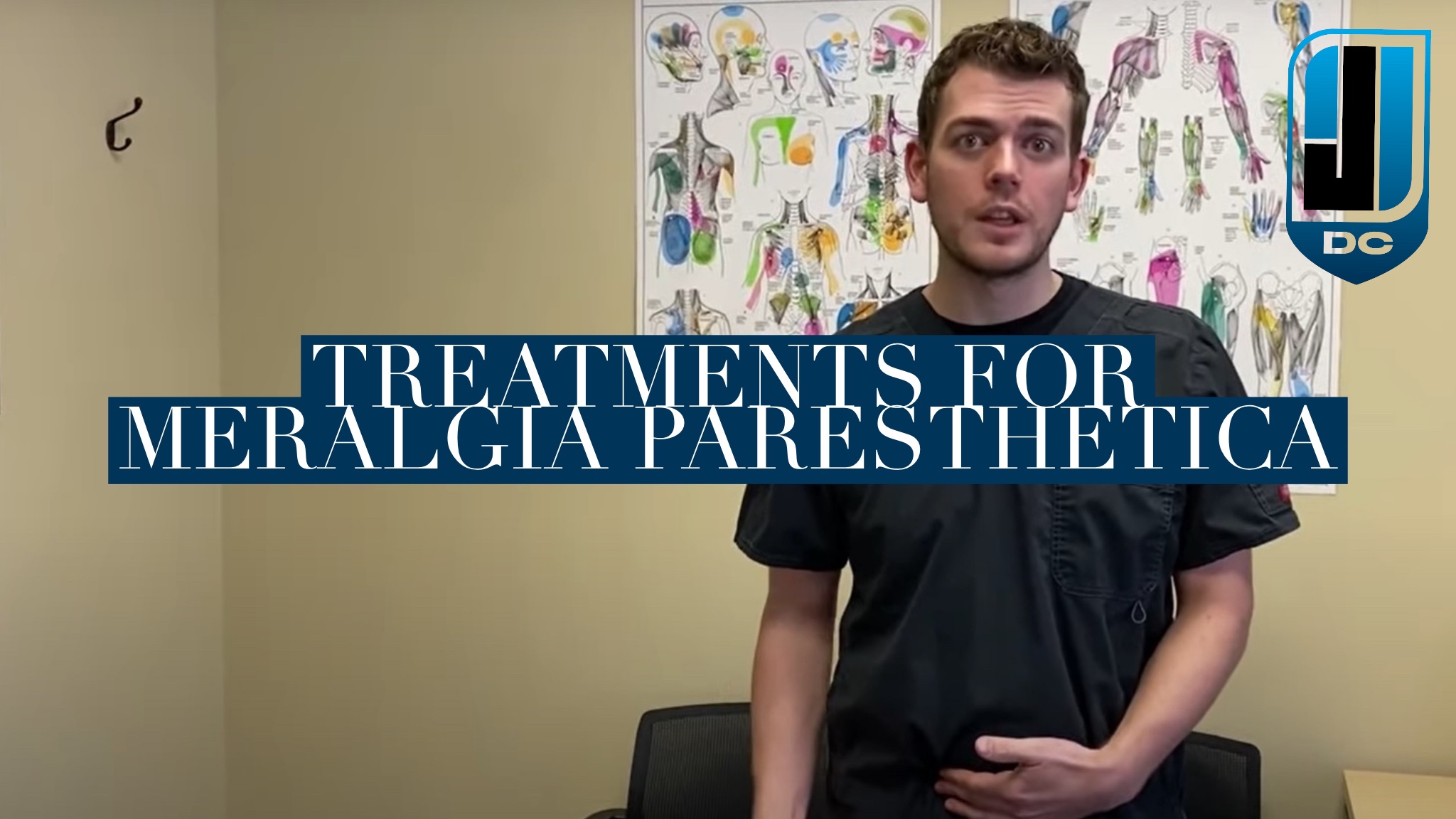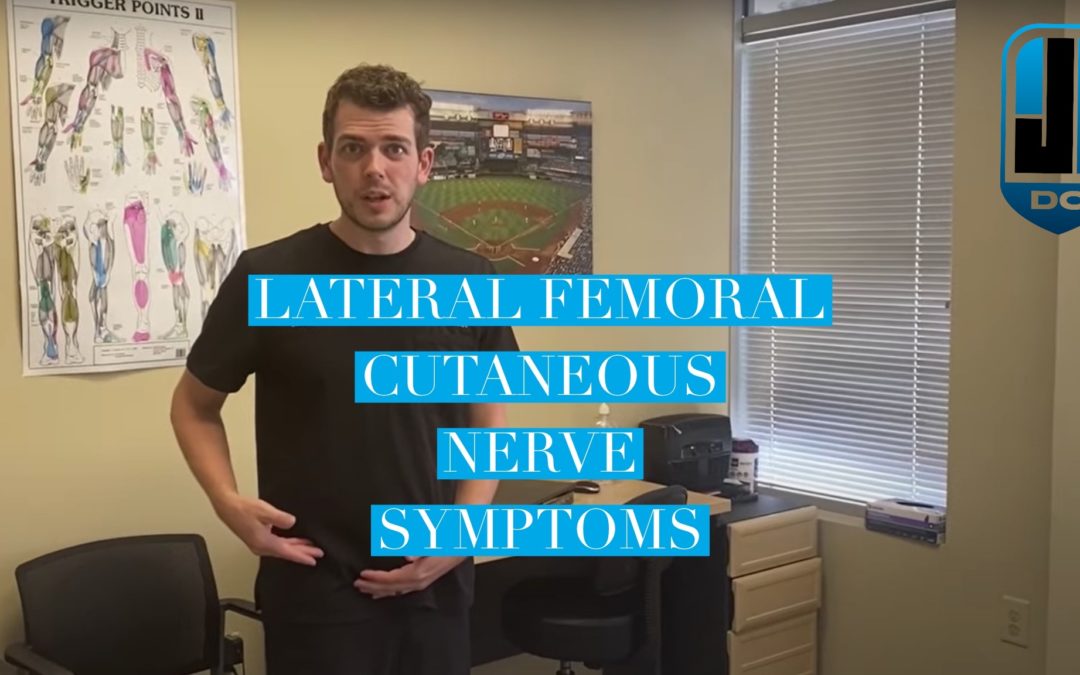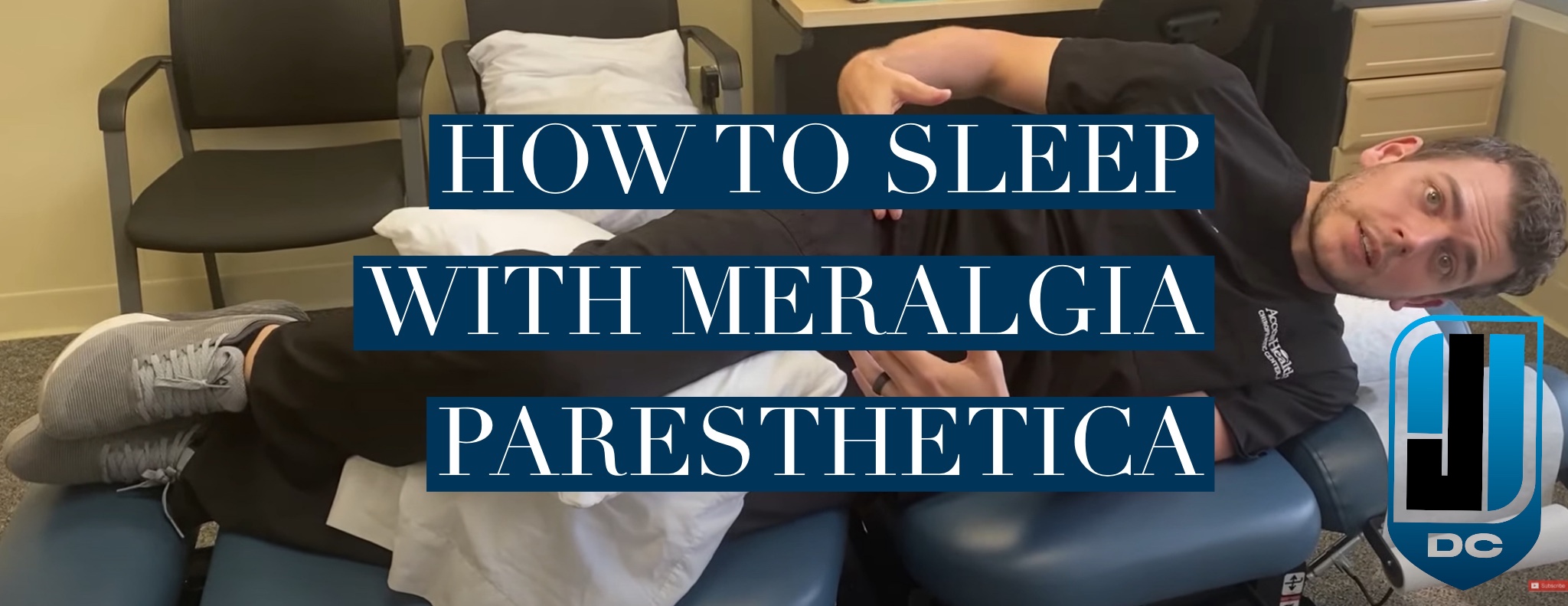Lateral Femoral Cutaneous Nerve symptoms are the what produce pain when you have Meralgia Paresthetica. Meralgia Paresthetica is a condition that causes burning, tingling, and abnormal sensation in the front of the thigh along the nerve. If you’re experiencing this discomfort you may be wondering, what’s causing it? This blog is part 2 of 3 where I answer ALL your questions about Meralgia Paresthetica and the Lateral Femoral Cutaneous Nerve. In this one I’ll answer:
- What are Lateral Femoral Cutaneous Nerve Symptoms?
- What are simple tests for Meralgia Paresthetica?
- Is burning in your thigh Meralgia Paresthetica or something else?
- Do I need an MRI if I have Meralgia Paresthetica?
- What conditions can mimic Lateral Femoral Cutaneous Nerve pain?
If you’re struggling with Lateral Femoral Cutaneous Nerve pain, make sure you read my other content. In it I discuss what Meralgia Paresthetica is and answer a lot of your other questions about it.
Part 1: What is Meralgia Paresthetica?
- What is Meralgia Paresthetica?
- What does the Lateral Femoral Cutaneous Nerve do?
- What does Meralgia Paresthetica feel like?
- Is Meralgia Paresthetica more common in certain people?
- What causes Meralgia Paresthetica?
- Can posture changes cause Meralgia Paresthetica?

Part 3: Treatments for Meralgia Paresthetica
- What’s the best treatment for Meralgia Paresthetica?
- How can I relieve Meralgia Paresthetica at home?
- What are home treatments for Meralgia Paresthetica?
- What are medical treatments for Meralgia Paresthetica?
What are Lateral Femoral Cutaneous Nerve Symptoms?
As a chiropractor, Meralgia Paresthetica is a condition I’ve seen quite a few times. The good news is that it typically only takes a good physical exam and history by a skilled chiropractor to diagnose Meralgia Paresthetica. Here is what I look for when I have a patient who suspected Lateral Femoral Cutaneous Nerve symptoms:
- Tenderness over the lateral inguinal ligament area. If you find the bony part of your pelvis in the front and go just inside to that and a bit below, this is the area that may be tender. Over 75% of people with MP will be tender here.
- Extending the hip will typically be uncomfortable and either reproduce or worsen symptoms of Meralgia Paresthetica. If you’re standing up, slide your leg backwards, while keeping it straight, and see if it’s bothersome.
- Lumbar extension will often be uncomfortable and reproduce or worsen symptoms of Meralgia Paresthetica. You can try this by standing straight up, raising your arms overhead, and leaning straight back. This would make me suspect MP if it creates the discomfort you’ve been feeling in the front of the thigh.
- Bending forward or hugging the thigh towards the chest will relieve the symptoms in someone who’s constant symptoms.
- Walking makes LFCN symptoms in the thigh worse and sitting makes them go away or reduce.
- When I passively extend a patient’s hip and/or knee in a prone (face down) position it typically makes symptoms worse.
- The muscles in the front of the thigh and hip are usually overly tight and generally tender. I always look at the iliopsoas (hip flexor), TFL, and sartorius muscles.
- More times than not those with Meralgia Paresthetica will have lower back, pelvis, and hip movement issues. These typically present as stiffness, pain, or inability to move through full ranges of motions or functional movements like a squat.
It’s important to know that you don’t need to have ALL of these symptoms to be suffering from Meralgia Paresthetica. These are the most common things I evaluate, and many patients will have at least a few of them. I also do more in an exam than only look for these signs and symptoms. My patients get a basic neurological exam and I’ll do an SFMA to see how they’re moving as a whole.
What are Simple Tests for Meralgia Paresthetica?
Simple tests for Meralgia Paresthetica can be very helpful for a doctor to make the correct diagnosis. There are two simple tests that I like to perform on patients who may have Lateral Femoral Cutaneous Nerve pain. These are for when the history and exam suggest Meralgia Paresthetica and I want confirm my diagnosis:
- Pelvic Compression Test: With the patient lying on their side, I’ll push the ASISs together to relieve tension on the inguinal ligament since it’s the most common region of compression. While I have it compressed for about 45 seconds I’ll ask the patient if the symptoms improve. If they do, it strengthens my diagnosis.
- LFCN Neurodynamic Test: While still side-lying I’ll extend the hip and knee while putting mild pressure over the posterior pelvis. This typically recreates symptoms or makes them worse.
Again, passing or failing these tests don’t rule in/out the condition. However, they are helpful tools for your doctor during an exam. You could probably even try these at home if you have someone to help.
Can’t Sleep with Meralgia Paresthetica?
Read my recommendations on how to sleep with Meralgia Paresthetica. I cover the 3 best sleeping positions to relieve pain in the Lateral Femoral Cutaneous Nerve.
Is Burning in Your Thigh Meralgia Paresthetica or Something Else?
There are a couple signs that, when they pop up during an exam, help me know your pain is probably not Meralgia Paresthetica likely something else.
- Weakness in the thigh or leg during the manual muscle strength testing part of the exam. The LFCN is purely a sensory nerve, so weakness SHOULDN’T be a symptom. If you have muscle weakness in your leg or thigh then you may have a femoral nerve radiculopathy. These are often caused by upper lumbar disc problems.
- Changes in your lower extremity reflexes also tell me your thigh pain is not Meralgia Paresthetica. Compression to the LFCN isn’t going to cause diminished or brisker reflexes compared to normal. If I find abnormal deep tendon reflexes during your exam, I’m concerned about a nerve root or central canal problem. These are typically more serious conditions.
Do I Need an MRI if I have Meralgia Paresthetica?
I do not order MRIs or other imaging right away if my exam shows that the burning and tingling in your thigh is Meralgia Paresthetica. An MRI is not imminent and it’s not necessary right away.
The best diagnostic studies for Meralgia Paresthetica are nerve conduction studies (NCS). These tests help evaluate how a nerve is conducting impulses. If there is compression on the LFCN or a traction injury then a NCS may show this.
An MRI isn’t typically appropriate unless I suspect a mass in the area or I think the patient really has lumbar radiculopathy. The can creating similar symptoms to Meralgia Paresthetica. I wouldn’t typically order either an NCS or MRI to evaluate the Lateral Femoral Cutaneous Nerve if there are no red flag signs. Instead, I’d suggest we do a trial of chiropractic care and rehab to see if we can get you feeling better first.
What Conditions Can Mimic Lateral Femoral Cutaneous Nerve Pain?
Other conditions that can create similar symptoms to Lateral Femoral Cutaneous Nerve pain include:
- Trigger point referrals from your gluteus medius muscle
- Trigger point referrals from your TFL muscle
- Abdominal, pelvic, or retroperitoneal pathology
- Diabetes and diabetic neuropathy
- Lumbar radiculopathy secondary to lumbar disc lesion or lateral IVF encroachment
One last thing that’s REALLY important! If you’re having symptoms of Meralgia Paresthetica it’s not good enough to diagnose yourself and hope you’re right. You should see a reputable rehab-focused chiropractor who can give you a comprehensive exam and diagnosis. As you can see from the above list, there are a number of more serious conditions that can cause similar symptoms to Lateral Femoral Cutaneous Nerve pain. I love educating my patients and those who are searching the web for help, but it’s not a substitute for a medical provider.

Jason Williams DC is a licensed Doctor of Chiropractic with Physical Therapy Modality and Acupuncture privileges. He is a chiropractor in Dumfries, VA at Sentara Therapy Center. Dr. Williams’ clinical expertise is in the evaluation, treatment, and rehabilitation of neuro-musculoskeletal conditions. Specific focuses include spinal, extremity, and sports-related complaints. He brings a patient-first attitude to his treatments and is a proponent of evidence-based and integrative care. See more content and his contact info here.
The opinions and views are mine personally, and do not necessarily reflect the views of others in the profession, my employer, or organizations that I belong to.



